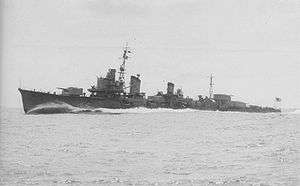Japanese destroyer Hayanami
 Hayanami underway on July 24, 1943 | |
| History | |
|---|---|
| Name: | Hayanami |
| Completed: | 21 July 1943 |
| Struck: | 10 August 1944 |
| Fate: | Sunk in action, 7 June 1944 |
| General characteristics | |
| Class and type: | Yūgumo-class destroyer |
| Displacement: | 2,520 long tons (2,560 t) |
| Length: | 119.15 m (390 ft 11 in) |
| Beam: | 10.8 m (35 ft 5 in) |
| Draught: | 3.75 m (12 ft 4 in) |
| Speed: | 35 knots (40 mph; 65 km/h) |
| Complement: | 228 |
| Armament: |
|
Hayanami (早波, "Shore Waves") was a Yūgumo-class destroyer of the Imperial Japanese Navy.
Design and description
The Yūgumo class was a repeat of the preceding Kagerō class with minor improvements that increased their anti-aircraft capabilities. Their crew numbered 228 officers and enlisted men. The ships measured 119.17 meters (391 ft 0 in) overall, with a beam of 10.8 meters (35 ft 5 in) and a draft of 3.76 meters (12 ft 4 in).[1] They displaced 2,110 metric tons (2,080 long tons) at standard load and 2,560 metric tons (2,520 long tons) at deep load.[2] The ships had two Kampon geared steam turbines, each driving one propeller shaft, using steam provided by three Kampon water-tube boilers. The turbines were rated at a total of 52,000 shaft horsepower (39,000 kW) for a designed speed of 35 knots (65 km/h; 40 mph).[3]
The main armament of the Yūgumo class consisted of six Type 3 127-millimeter (5.0 in) guns in three twin-gun turrets, one superfiring pair aft and one turret forward of the superstructure.[2] The guns were able to elevate up to 75° to increase their ability against aircraft, but their slow rate of fire, slow traversing speed, and the lack of any sort of high-angle fire-control system meant that they were virtually useless as anti-aircraft guns.[4] They were built with four Type 96 25-millimeter (1.0 in) anti-aircraft guns in two twin-gun mounts, but more of these guns were added over the course of the war. The ships were also armed with eight 610-millimeter (24.0 in) torpedo tubes in a two quadruple traversing mounts; one reload was carried for each tube. Their anti-submarine weapons comprised two depth charge throwers for which 36 depth charges were carried.[2]
Construction and career
From 15–20 October 1943, Hayanami was used on troop transport runs from Saeki to Truk. The destroyer was used on troop transport runs from Truk to Ponape on 22-24 and 26–28 October. She provided escort for a troop transport run on 6 November to Bougainville.
On 7 June 1944, Hayanami was torpedoed and sunk by the submarine USS Harder near Tawitawi, 35 miles (56 km) east of Borneo (04°43′N 120°03′E / 4.717°N 120.050°ECoordinates: 04°43′N 120°03′E / 4.717°N 120.050°E). The ship blew up and sank with 208 killed; 45 survivors were rescued by the destroyer Urakaze.
On 10 August 1944, Hayanami was removed from the Navy List.
Notes
References
- Campbell, John (1985). Naval Weapons of World War II. Annapolis, Maryland: Naval Institute Press. ISBN 0-87021-459-4.Campbell, John (1985). Naval Weapons of World War II. Annapolis, Maryland: Naval Institute Press. ISBN 0-87021-459-4.
- Chesneau, Roger, ed. (1980). Conway's All the World's Fighting Ships 1922–1946. Greenwich, UK: Conway Maritime Press. ISBN 0-85177-146-7.
- Jentschura, Hansgeorg; Jung, Dieter & Mickel, Peter (1977). Warships of the Imperial Japanese Navy, 1869–1945. Annapolis, Maryland: United States Naval Institute. ISBN 0-87021-893-X.
- Whitley, M. J. (1988). Destroyers of World War 2. Annapolis, Maryland: Naval Institute Press. ISBN 0-87021-326-1.